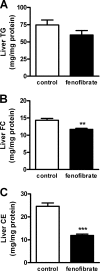Fenofibrate increases very low density lipoprotein triglyceride production despite reducing plasma triglyceride levels in APOE*3-Leiden.CETP mice
- PMID: 20501652
- PMCID: PMC2919079
- DOI: 10.1074/jbc.M110.123992
Fenofibrate increases very low density lipoprotein triglyceride production despite reducing plasma triglyceride levels in APOE*3-Leiden.CETP mice
Abstract
The peroxisome proliferator-activated receptor alpha (PPARalpha) activator fenofibrate efficiently decreases plasma triglycerides (TG), which is generally attributed to enhanced very low density lipoprotein (VLDL)-TG clearance and decreased VLDL-TG production. However, because data on the effect of fenofibrate on VLDL production are controversial, we aimed to investigate in (more) detail the mechanism underlying the TG-lowering effect by studying VLDL-TG production and clearance using APOE*3-Leiden.CETP mice, a unique mouse model for human-like lipoprotein metabolism. Male mice were fed a Western-type diet for 4 weeks, followed by the same diet without or with fenofibrate (30 mg/kg bodyweight/day) for 4 weeks. Fenofibrate strongly lowered plasma cholesterol (-38%) and TG (-60%) caused by reduction of VLDL. Fenofibrate markedly accelerated VLDL-TG clearance, as judged from a reduced plasma half-life of glycerol tri[(3)H]oleate-labeled VLDL-like emulsion particles (-68%). This was associated with an increased post-heparin lipoprotein lipase (LPL) activity (+110%) and an increased uptake of VLDL-derived fatty acids by skeletal muscle, white adipose tissue, and liver. Concomitantly, fenofibrate markedly increased the VLDL-TG production rate (+73%) but not the VLDL-apolipoprotein B (apoB) production rate. Kinetic studies using [(3)H]palmitic acid showed that fenofibrate increased VLDL-TG production by equally increasing incorporation of re-esterified plasma fatty acids and liver TG into VLDL, which was supported by hepatic gene expression profiling data. We conclude that fenofibrate decreases plasma TG by enhancing LPL-mediated VLDL-TG clearance, which results in a compensatory increase in VLDL-TG production by the liver.
Figures





Similar articles
-
ApoAV reduces plasma triglycerides by inhibiting very low density lipoprotein-triglyceride (VLDL-TG) production and stimulating lipoprotein lipase-mediated VLDL-TG hydrolysis.J Biol Chem. 2004 Jul 2;279(27):27941-7. doi: 10.1074/jbc.M403240200. Epub 2004 Apr 16. J Biol Chem. 2004. PMID: 15090553
-
Effect of fenofibrate and niacin on intrahepatic triglyceride content, very low-density lipoprotein kinetics, and insulin action in obese subjects with nonalcoholic fatty liver disease.J Clin Endocrinol Metab. 2010 Jun;95(6):2727-35. doi: 10.1210/jc.2009-2622. Epub 2010 Apr 6. J Clin Endocrinol Metab. 2010. PMID: 20371660 Free PMC article. Clinical Trial.
-
Metformin lowers plasma triglycerides by promoting VLDL-triglyceride clearance by brown adipose tissue in mice.Diabetes. 2014 Mar;63(3):880-91. doi: 10.2337/db13-0194. Epub 2013 Nov 22. Diabetes. 2014. PMID: 24270984
-
Omega-3 fatty acids eicosapentaenoic acid and docosahexaenoic acid and their mechanisms of action on apolipoprotein B-containing lipoproteins in humans: a review.Lipids Health Dis. 2017 Aug 10;16(1):149. doi: 10.1186/s12944-017-0541-3. Lipids Health Dis. 2017. PMID: 28797250 Free PMC article. Review.
-
Regulation of plasma triglycerides in insulin resistance and diabetes.Arch Med Res. 2005 May-Jun;36(3):232-40. doi: 10.1016/j.arcmed.2005.01.005. Arch Med Res. 2005. PMID: 15925013 Review.
Cited by
-
Fenofibrate Treatment Inhibits Very-Low-Density Lipoprotein Transport Vesicle Formation by Reducing Sar1b Protein Expression.Int J Mol Sci. 2025 May 15;26(10):4720. doi: 10.3390/ijms26104720. Int J Mol Sci. 2025. PMID: 40429862 Free PMC article.
-
Beneficial effects of elafibranor on NASH in E3L.CETP mice and differences between mice and men.Sci Rep. 2021 Mar 3;11(1):5050. doi: 10.1038/s41598-021-83974-8. Sci Rep. 2021. PMID: 33658534 Free PMC article.
-
Brown fat activation reduces hypercholesterolaemia and protects from atherosclerosis development.Nat Commun. 2015 Mar 10;6:6356. doi: 10.1038/ncomms7356. Nat Commun. 2015. PMID: 25754609 Free PMC article.
-
cAMP response element binding protein H mediates fenofibrate-induced suppression of hepatic lipogenesis.Diabetologia. 2013 Feb;56(2):412-22. doi: 10.1007/s00125-012-2771-2. Epub 2012 Nov 13. Diabetologia. 2013. PMID: 23150180
-
Atherosclerosis: an overview of mouse models and a detailed methodology to quantify lesions in the aortic root.Vasc Biol. 2024 Apr 4;6(1):e230017. doi: 10.1530/VB-23-0017. Print 2024 Jan 1. Vasc Biol. 2024. PMID: 38428154 Free PMC article. Review.
References
-
- Boden W. E. (2000) Am. J. Cardiol. 86, 19L–22L - PubMed
-
- Nordestgaard B. G., Benn M., Schnohr P., Tybjaerg-Hansen A. (2007) JAMA 298, 299–308 - PubMed
-
- Chapman M. J. (2003) Atherosclerosis 171, 1–13 - PubMed
-
- Schoonjans K., Staels B., Auwerx J. (1996) Biochim. Biophys. Acta. 1302, 93–109 - PubMed
-
- Staels B., Dallongeville J., Auwerx J., Schoonjans K., Leitersdorf E., Fruchart J. C. (1998) Circulation 98, 2088–2093 - PubMed
Publication types
MeSH terms
Substances
LinkOut - more resources
Full Text Sources
Molecular Biology Databases
Miscellaneous

